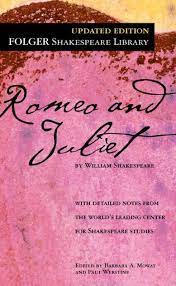“ROMEO AND JULIET”: REAL MORALS, ADAPTATION, AND CURRICULUM
“Romeo and Juliet”:

The entirety of this review deals with the plot of “Romeo and Juliet,” as such, suicide is mentioned, and readers should proceed with awareness. Additionally, this is the spoiler warning for “Romeo and Juliet” if you have not read/seen it.
“Romeo and Juliet” is an anomaly when it comes to required reading. When you strip away the recognizable character names-and ignore Shakespeare’s authorship- the story can roughly be distilled as: Teenagers from opposite sides of a family rivalry defy authority, fall in love, and pay the price in blood. The story features three murders, two suicides, a wedding night, and blatant disregard for the rules imposed by adults- its the stuff book-banning dreams are made of. However, with rare exception, “Romeo and Juliet” is not banned, and has become a rite of passage in high school English classes. I am unabashedly in love with the play, but I am less enamored with the way it is taught. Shakespeare penned “Romeo and Juliet” between 1591-1596- it’s about time we viewed (and taught) it with nuance.
Set in Verona, Italy, “Romeo and Juliet” is the story of the Montague and Capulet families, their blood-soaked rivalry, and the way hatred impacts their children and community. When Romeo and Benvolio Montague, along with their friend (and brethren to the prince) Mercutio, sneak into a party held by the Capulet family, Romeo meets Juliet Capulet (the cousin of Tybalt and fixture of Paris’ courtship) and the two fall in love. The attendance of Montague boys and Mercutio at the party escalates pre-existing tensions, and, in a series of inter-familial and feud-related conflicts, the young people of Verona have paid the price of the violence in blood. Mercutio has been killed by Tybalt, Tybalt and Paris have been killed by Romeo, and Juliet and Romeo themselves have taken their own lives. This spilling of young blood is finally enough to awaken the awareness of the adults, who finally lay their rivalry to rest.
Unsurprisingly, the romance between Romeo and Juliet is the aspect of the story that gets the most attention (and criticism). When I read it in class, our assignments asked questions about the strength of love, and whether or not we believed in the concept of ‘love at first sight.’ The much more pressing moral questions about the justification of violence, enablement, and the association between aggression and strength were all but forgotten- unnoticed footnotes. Viewing the play through this ‘love lens’ negates the beauty of the story- turning Romeo and Juliet from sheltered children into melodramatic overreactors, glorifying their hasty relationship, and using their deaths to martyr them- why not die for love? Once you take a step back and read “Romeo and Juliet” without the added layer of romance, it becomes obvious that it is not truly a love story- or at least not one in the traditional sense.
“Romeo and Juliet” showcases a variety of loving relationships: Familial love between Benvolio and Romeo, platonic love of Romeo and Mercutio, the connection between mentor and mentee with Friar Lawrence and Romeo, and the complex relationships between parents and children. The star-crossed lovers are only one kind of love in a story that captures the full human experience – from hate to love to infatuation and back again. “Romeo and Juliet” isn’t meant to be taken as an endorsement of the title characters’ relationship so much as a laying-bare of the price of hatred and the way it destroys everyone.
The price of the hatred between the Montague and Capulet families is the lives of the younger generation. Lord and Lady Capulet as well as Lord and Lady Montague are culpable in what has happened through their complacency and enabling. It is the behavior of the adults that the children model themselves after, the people they take their cues from, and it is the adults who back their young into a corner- who take their children’s voices away. The main characters represent a range of buy-in, from Juliet’s vigorous disbelief to Tybalt’s complete faith in the rightness of the feud. There is hope that the next generation will rectify the wrongs of those before them, but there is also a warning that children are taught quickly, and hatred is a poisonous seed that is easy to plant. And hatred is not the only seed sown in Verona; violence and retaliations also flourish. With the notable exception of Benvolio, all of the male characters take some enjoyment in antagonizing one another. Tybalt is excited at the prospect of attacking the Montagues, Mercutio finds more honor and glory in fighting than in walking away from violence, and Romeo, though hesitant at first, agrees to go with his friends to stir trouble. The culture around them has not only justified violence, but has equated aggression with strength. The character of Benvolio shows this equation as he is a pacifist and is also portrayed as being naive, young, and in need of the council of others.
When considering this, the character of Romeo contains complexity not seen at first. In his choice to abstain from fighting Tybalt, Romeo indicates a change: he is not simply rejecting the ease of a fight, he is refusing to play into the societal norm. Romeo may be fickle in his devotions, but he makes no excuse for his pursuit of love. His declarations of feelings are overblown, but come from the mind of someone who has been sheltered from these emotions- his attempts to pursue love are brave in the climate he finds himself in.
Romeo may go against the grain, but Mercutio and Tybalt are easily the most compelling characters- both are strong willed and dedicated to their own goals (which for Tybalt consists of upholding family honor and for Mercutio consists of rambling speeches that are strangely sensical). Both clearly buy into the rivalry around them, but while Tybalt feels a moral obligation to do so, Mercutio seems to find the situation exciting- and will retaliate when he feels he has been wronged. The death of these two characters also represents some complicated questions: Is revenge a worthy goal? Tybalt initially challenges Romeo to duel, and when Romeo refuses, Mercutio takes his place. Mercutio enters the fight full of pride and is killed when Tybalt’s blade passes under Romeo’s arm and stabs him. It is only as he lies dying that Mercutio’s worldview begins to break down- it is here that he resents the feud, and the price it has cost him. Mercutio is neither Capulet or Montague and yet pays for their conflict. The death of Mercutio is the impetus for Romeo to kill Tybalt in response and the action that gets him banished to Mantua- which results in the end conflict. Acknowledging the pattern of normalized violence gives the story a different color. It’s not advocating for teenagers to get married- it’s warning that the younger generations reap the consequences of the older generation’s choices. The young are struggling to survive in the world that has been made for them, and unable (or unwilling) to change anything, are going to pass the same world on to their children.
In addition to rethinking what elements of the story get focused on, we should also pay more attention to the various adaptations throughout the years, and the additional meaning they add to the original. Not only should students read the play, we should watch multiple performances of it- whether film or pro-shot of a stage production- we should read other authors’ take on the narrative and consider how this changes our perception of the original.
Recent productions of “Romeo and Juliet” have messed around with various elements of the narrative. The 2013 revival of the play with Orlando Bloom and Condola Rashad uses the original Shakespearean script while costuming the characters in modern clothes and dressing the story with modern sets (like Baz Luhrman’s Romeo + Juliet), as well as casting the Montague family as white and the Capulet family as African-American. National Theater released a movie version of the play in 2021 after the play’s stage opening was delayed. National Theater’s version also utilizes modern stylism, but takes its minimalist set one step further with almost no props or decorations except for a moving wall. By and large the characters remain the same except for the reversal of roles between Lord and Lady Capulet and the connection between Mercutio and Benvolio- which is made romantic. The dialogue between the pair takes on a new energy: they are opposite, but they clearly click. Hatred not only ruins Romeo and Juliet’s love, but also Benvolio and Mercutio’s.
Books have also tasked themselves with adapting the story in new ways, from transporting the story to 1920s Shanghai (courtesy of Chloe Gong’s “These Violent Delights” duology) to adding paranormal aspects (Stacy Jay’s “Juliet Immortal” pair of books- which were physically hard to read) to a book in which two romantics meet while performing in a musical based on “Romeo and Juliet” (Dana L. Davis’ “Roman and Jewel”). Regardless of the actual quality of these stories, they provide additional perspectives and insights into the story- highlighting new elements and coloring familiar aspects in a new light.
“Romeo and Juliet” is still more than worthy of its place as a classic, but to ensure that the true beauty of the story is revealed, we need to teach it in a more critical, challenging way. To fully understand the morality of the narrative, we need to implement new material to co-teach with the play. It’s time to put the traditional love story to rest and explore the idea of love between various people, and most importantly, to see the ways that love and hatred ripple.
9.8/10 would flee Verona again
Further breakdown:
Writing Quality: 9.5/10 Enjoyability: 9.5/10
Pace: 9/10 Visual elements: N/A
Plot development: 9/10 Insightfulness: 10/10
Characters: 10/10





